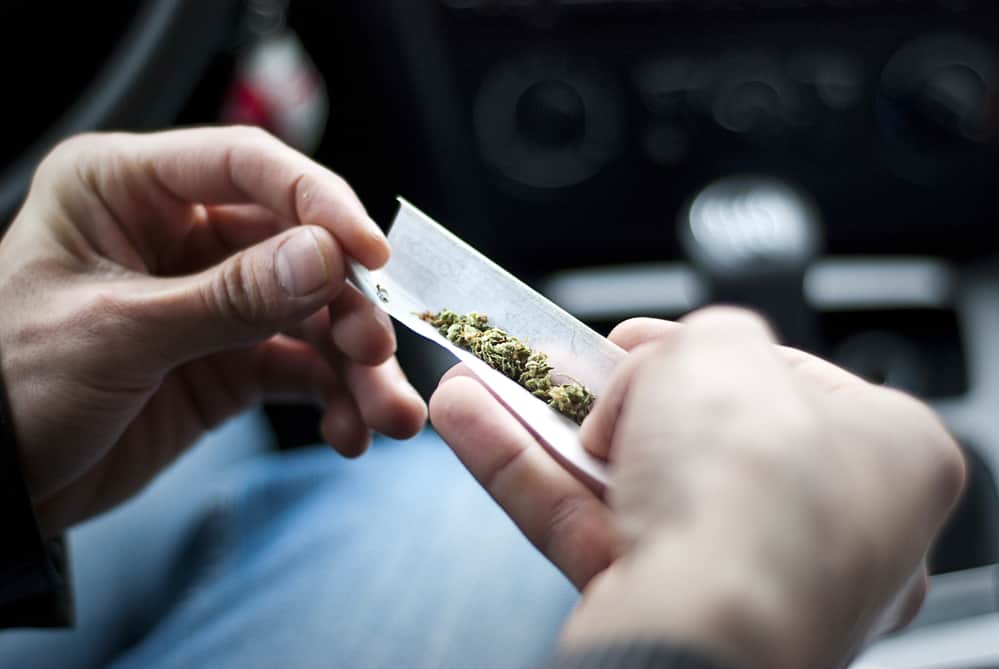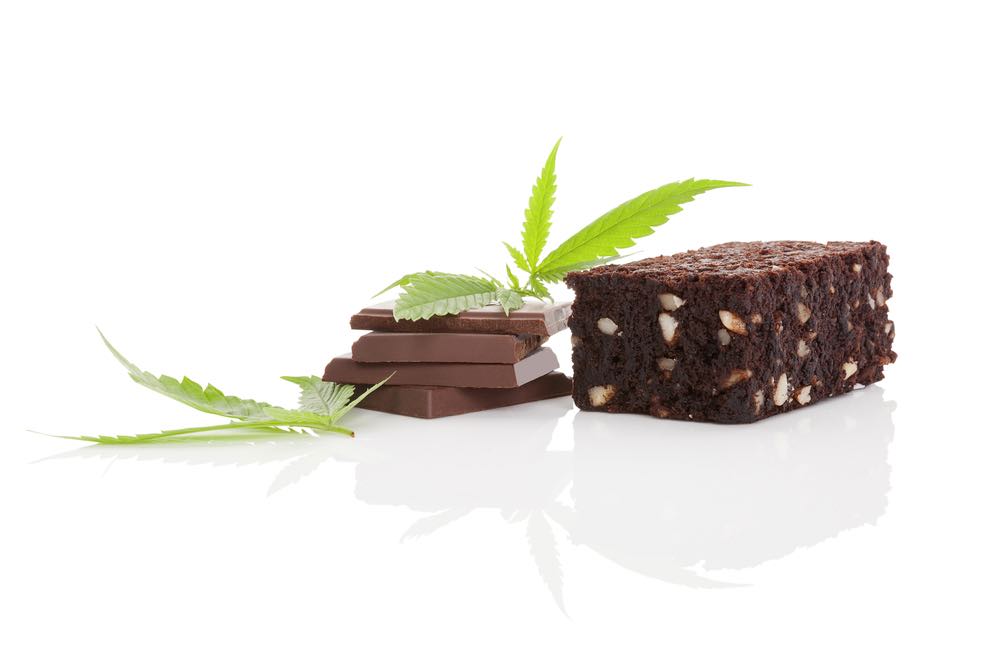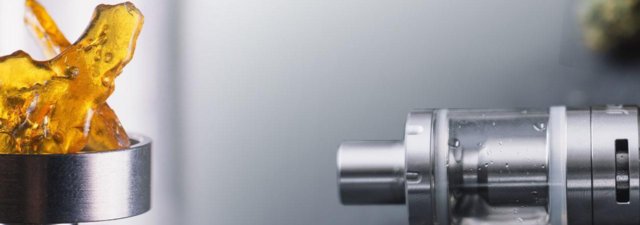The simple assumption is that smoking marijuana is less healthy than eating it. After all, the former process involves inhaling combusted material and potentially carcinogenic substances. When you consume an edible, it passes ‘safely’ through the digestive system, and the THC goes into the bloodstream. It is a much cleaner and easier way to enjoy an intoxicating high.
However, it is incorrect to assume that cannabis edibles are entirely safe and healthy. There is evidence that this form of consumption increases the risk of hospitalization.
The issue is far from being cut and dried. In this article, we compare edibles vs. smoking. This involves checking out the possible health risks and benefits of inhaling and ingesting cannabis. We include vaping along with smoking in the ‘inhalation’ category. Ingesting marijuana relates to eating or drinking it.
Smoking vs. Edibles – A Quick Overview
Inhaling
Question | Answer |
|---|---|
What Is the Process? | You smoke or vape marijuana. The smoke or vapor delivers THC into the lungs where it passes directly into the bloodstream, and then the brain. |
When Do You Begin to Feel the Effects? | From within a few seconds to a few minutes. |
When Are the Peak Effects? | Within 30 minutes. |
How Long Do the Effects Last? | Potentially up to 6 hours depending on potency and amount used. Residual effects could last up to 24 hours. |
Ingesting
Question | Answer |
|---|---|
What Is the Process? | Edible marijuana travels to the stomach and then the liver. It eventually makes it into the bloodstream and brain. The digestive system metabolizes a higher level of cannabinoids than with inhalation. |
When Do You Begin to Feel the Effects? | Usually 30-120 minutes. |
When Are the Peak Effects? | Approximately 4 hours after use. |
How Long Do the Effects Last? | Up to 12 hours. Residual effects can last up to 24 hours. |
Smoking cannabis is the ‘classic’ form of use. In previous generations, some people saw the act of smoking weed as ritualistic. Regular smokers of marijuana enjoy the social aspect and like the fact it provides a relatively fast intoxicating high. For many MMJ users, it is essential to feel any potential effects as soon as possible. For example, people in chronic pain don’t want to wait several hours to feel relief.
In recent times, the vaping industry has exploded in popularity. Proponents of this process believe it removes many of the negatives associated with smoking. Vaporizers heat e-liquid into vapor, which the user inhales. The vapor is more refreshing than smoke and less irritating to the lungs. It also doesn’t produce a lingering smell. You can also retain the social aspect of smoking by seeking out fellow vapers.
Vaping provides a significantly faster-acting high than edibles. It is also more discreet than smoking. There are many tiny portable vape pens on the market that you can conceal in your hand or pocket. For medical use, vaping doesn’t combust cannabis, so you benefit from hundreds of cannabinoids and terpenes.
Whether you smoke or vape cannabis, there also comes a time when you know to put down the vaporizer, bong, dab rig, or joint. Inhaled marijuana goes immediately beyond the blood-brain barrier. Once a user decides they have ‘had enough,’ they can quickly stop.
What Are the Problems with Inhaling Marijuana?
The issues associated with smoking cannabis are well-known:
- It can damage your lungs’ first line of defense against infections by killing the cells that remove bacteria and dust from the air.
- It potentially suppresses the immune system, leading to a higher risk of lower respiratory tract infections.
- Users find it extremely difficult to ‘measure’ a dose.
- The combustion process releases potential carcinogens.
- Excessively heated cannabis loses many terpenes and cannabinoids.
- The smoke leaves a terrible smell.
- You can’t have a secret smoke in a public place!
Proponents of vaping point out that it doesn’t have any of these issues. However, vaping has its risks. The vaping epidemic of 2019 showed what happens in a poorly regulated market. Thousands of people were hospitalized after vaping cannabis oil, and at least 60 of them died.

Vape e-juice contains thinning agents. The likes of propylene glycol (PG) and PEG 400 produce carcinogens such as formaldehyde when heated to specific temperatures. There is also ample evidence that excessive vaping can irritate the lungs, too.
Why Do People Use Edibles?
The main reason is to avoid lung irritation. State-licensed dispensaries sell edible cannabis products that are already decarboxylated, which means compounds such as THC and CBD are activated.
Edibles are also extremely easy to use, and you can, theoretically, enjoy them in public (even though using cannabis in a public place remains illegal). Eating marijuana is as simple as unwrapping a product and swallowing it. Consuming THC beverages is just as easy.
You also know precisely how much THC or CBD is in an edible, assuming the brand in question offers third-party lab reports.
Those looking for a longer-lasting effect tend to choose cannabis edibles. It can take up to two hours to affect, but the intoxication lasts far longer.
What Are the Problems with Ingesting Edibles?
People in the pro-edible camp claim that eating marijuana makes it easier to dose. This seems logical in theory. In practice, this form of consumption has similar issues to inhaled products.
States such as Washington and Colorado have created ‘single-serving guidelines’ and required that products are labeled to show the amount of THC in an edible, along with the number of servings.

However, the production of edibles is not well monitored. Manufacturers routinely find it challenging to create edibles mixtures with consistent THC levels. One batch can contain far more THC than the next. You could eat one chocolate bar with 5mg of THC. A few days later, you could eat another one from the same brand, and it could have 25mg of THC!
There is also the issue of packaging. Cannabis edibles often look like candy, making it easy for a child to come across a container and eat the contents.
There Is the Potential for Serious Harm
The best-known issues with edibles are the intensity of the high and the length of time they take to effect. Inexperienced users often try an edible. When they feel no effects within an hour or so, they eat even more THC. Suddenly, they are hit with a terrifying experience that could lead to a psychotic reaction. There are stories of people overeating cannabis and placing themselves in grave danger.
In 2012, the state of Colorado voted to legalize recreational cannabis. In the next few years, doctors at the University of Colorado Hospital in Denver noticed a surprising trend.
The majority of people who ended up in the ER for cannabis-related complaints had smoked the substance. Hardly a shock. Yet, those who ate the drug were more likely to have severe side effects, including heart problems and psychiatric symptoms.
From 2012 to 2016, only 9% of marijuana-linked ER visits to the University of Colorado Hospital related to edibles. However, 18% of these individuals suffered symptoms such as psychosis and anxiety, compared to 11% of people who smoked it.
Edible High vs. Smoking High
It is clear to experienced users that an edible high vs. a smoking high leads to two very different experiences. While both make you feel high, edibles tend to provide a more sedative effect that results in couch-lock. It can take up to two hours to affect, but the high you feel from consuming edibles could last up to six hours.
When smoking cannabis, the high is more likely to have a cerebral effect. Depending on the strain, you might feel more energized than when you use an edible. You will probably feel the high from smoked marijuana within a matter of minutes, if not sooner. However, the intoxication hits a peak in 30-60 minutes and tapers off within 2-4 hours.
Are Edibles Stronger Than Smoking Cannabis?
‘How’ you consume cannabis does play a major role in its effects. In general, the high from edibles is considered more potent than the intoxication felt from smoking or vaping the product.
It boils down to how the substance is absorbed into the bloodstream. Cannabis isn’t metabolized differently with both forms of consumption, as some people think. Instead, THC and other cannabinoids are metabolized to varying levels in different parts of the body, depending on how you consume the drug.
Difference Between Smoking and Edibles
When you ingest cannabis, a significantly larger amount of delta-9-THC makes it to the liver first than when you inhale cannabis. If you smoke or vape the drug, the ratio of 11-hydroxy-THC to delta-9-THC is much lower than when you eat marijuana.
11-hydroxy-THC is a cannabinoid that’s potentially stronger than delta-9-THC, but there isn’t much research on it. A study published in 1973 involved nine volunteers who were injected with 1mg of 11-hydroxy-THC. Later, they were injected with 1mg of THC and asked to rate their high on a 0-10 scale.
11-hydroxy-THC is potentially stronger than delta-9, and it may be more prevalent in edibles than in smokable goods.
The volunteers reported pronounced psychological and pharmacologic effects. All nine of them reported feeling the greatest psychologic high as a 2-3 after using 11-hydroxy-THC. They all said the high was greater than what they experienced after using delta-9-THC.
The Journey of Cannabinoids
When you smoke cannabis, the THC gets into your bloodstream through the alveoli in the lungs. However, THC is oil-soluble, which means it doesn’t break down effectively in blood. Remember, blood is primarily comprised of water. THC tries to bind with our body’s endocannabinoid receptors within seconds and doesn’t have much of a chance to get metabolized by our GI tract.
After ingesting marijuana, your saliva starts breaking down the THC almost immediately. After it gets to the stomach and liver, the THC becomes 11-hydroxy-THC. At this stage, it is a glucuronide compound, which makes the 11-hydroxy-THC more water-soluble. It finds it easier to diffuse across the blood-brain barrier. When metabolized, 11-hydroxy-THC’s journey to the brain and body is much faster.
This is why the high from edibles is longer and stronger than when you smoke cannabis, despite taking longer to kick in.
Edibles vs. Smoking Anxiety
There are side effects associated with smoking marijuana and edible marijuana. These effects are more likely to occur with edibles due to overconsumption. It is much easier to accidentally eat 100mg of THC in a brownie than to smoke it. Anxiety is one of the most common side effects associated with the overuse of cannabis.
Anecdotal reports suggest that edibles feel frightening to some people due to the heightened delusional symptoms they cause. Apart from excessive consumption, the 11-hydroxy-THC compound is also responsible for creating a greater level of anxiety with edibles than with dry herb.
11-hydroxy-THC activates certain receptors in the brain more fully than delta-9-THC. This is why you typically experience a more intense and occasionally scary high with edibles.
Which Method of Consumption Is Safer?
In a world where cannabis users knew their limits and consumed weed sensibly, ‘edibles’ would be the easy winner in the safety stakes. Smoking cannabis potentially damages the lining of the lungs and causes irritation. It also produces carcinogenic substances and burns away many vital compounds that could help MMJ users.
While vaping doesn’t produce nearly as many harmful chemicals, it can produce formaldehyde and other damaging substances depending on the thinning agent. Some e-liquids also contain ingredients such as vitamin E acetate, which causes severe illness.
Vaping is easier on the lungs but doesn’t guarantee freedom from respiratory problems.
However, we don’t live in a world where people do ANYTHING sensibly most of the time. Sadly, it is almost routine to hear cases where someone eats too much marijuana and suffers the consequences. The result is an ER trip or worse.
The information on hospitalizations we mentioned earlier comes from a study published in the Annals of Internal Medicine in March 2019. One of the most concerning pieces of data related to heart symptoms. 8% of patients who went to the ER at the University of Colorado Hospital had symptoms such as an irregular heartbeat. There were even a few cases of heart attacks! In contrast, only 3.1% of smokers suffered from these issues.
It is essential to understand that the study only shows a correlation. It doesn’t prove that smoking or ingesting cannabis causes these issues. Edibles users possibly had a frightening experience that significantly elevated their heart rate for an extended period.
Final Thoughts on Edibles Versus Smoking Cannabis
Overall, edibles are safer in a general sense. However, this is only the case if you use them sensibly. Begin with a minimal amount, less than half of the ‘recommendation’ on the label. If nothing happens for an hour, stay patient. Don’t consume anything else for the rest of the day. If you experience little or no effect, you could try a slightly more significant amount the next time.
Whether you smoke or vape cannabis, make sure you understand the possible risks to your lungs. Individuals with respiratory issues should stick to edibles or orally consumed tinctures. Regardless of the method of consumption, we must urge caution. You should also perform detailed research into any brand you are interested in. No matter how sensible you are, low-quality vape juice, dry herb, or edibles could cause health problems.
FAQs
Can I Develop an Immunity to Edibles?
Regular cannabis users can build up a tolerance to THC. They find that marijuana no longer has the same effect as it used to. Edibles are no different in this regard. Estimates vary, but up to 15% of people can’t properly process orally consumed cannabinoids.
Are Edibles Different Than Smoking?
Yes, there are numerous differences. One of the most relevant is the effects cannabinoids have on your body and brain. Ultimately, the high you experience from an edible takes longer to have an impact than with smoking. However, the high lasts longer and is more potent.
Are Edibles Bad for Your Lungs?
It is assumed that smoking cannabis is bad for your lungs. In particular, individuals with asthma find cannabis smoke irritating to the lungs. In contrast, there is little evidence that edibles hurt the lungs. Therefore, it is a better method of consumption for individuals with respiratory issues.
Do Edibles Mess up Your Liver?
As edibles are processed through the liver, there is a concern that regular consumption could cause problems. However, at present, there are very few useful studies available that focus on this issue.
So far, most research relates to individuals with liver problems. For instance, chronic marijuana use could worsen the symptoms of hepatitis C. Yet at present, no data suggests any form of marijuana use damages the liver cells in people with healthy livers.


![How to Avoid Getting the Munchies When High [Tips]](https://wayofleaf.com/wp-content/uploads/2019/03/wol_how-to-not-get-the-munchies-when-high-640x225.jpg)


![What’s the Best Way to Take CBD Oil? [ANSWERED]](https://wayofleaf.com/wp-content/uploads/2018/08/wol_1920x450-75-640x225.jpg)





![The Best Uses for Terpene Oil [Explained]](https://wayofleaf.com/wp-content/uploads/2020/10/wol_the-best-uses-for-terpene-oil-640x225.jpg)
